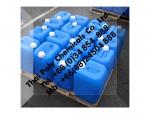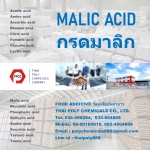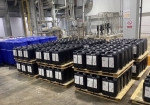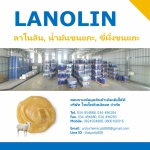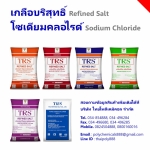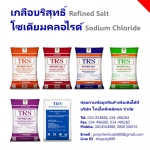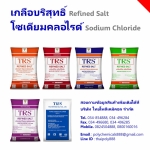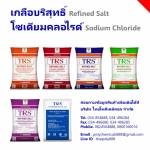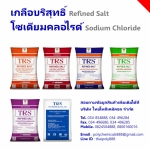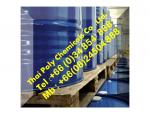Phosphoric acid , ฟอสฟอริกแอซิด, ฟอสฟอริกเอซิด, กรดฟอสฟอริก, H3PO4, ฟอสฟอริค |
฿1 |
|
ชื่อผู้ประกาศ : อัศวิน เบอร์โทรศัพท์ : 034854888, 034496284 โทรศัพท์มือถือ : 0800160016 ที่อยู่ : 36/5 ม.9 ต.นาดี อ.เมืองสมุทรสาคร ร้าน TPCC |
นำเข้าและจำหน่าย Phosphoric
acid , ฟอสฟอริกแอซิด,
ฟอสฟอริกเอซิด, กรดฟอสฟอริก, H3PO4, ฟอสฟอริค สอบถามข้อมูลเพิ่มเติมได้ที่
ฝ่ายขาย บริษัท
ไทยโพลีเคมิคอล จำกัด โทรศัพท์ 034854888, 034496284 มือถือ 0824504888,
0800160016 โทรสาร 034854899, 034496285
Phosphoric
Acid, กรดฟอสฟอร์ริก, ฟอสฟอร์ริกแอซิด
ฟอสฟอริค (Phosphoric)
ชื่อเคมีทั่วไป
: Phosphorus
pentoxide
ชื่อพ้องอื่นๆ
: Phosphorous
pentaoxide; Phosphoric; Phosphoric anhydride; Phosphoric pentoxide; Phosphorus(V) oxide; Phosphorus oxide; Diphosphorus pentaoxide; Diphosphorus
กรดฟอสฟอริก
(Phosphoric
acid) เป็นกรดแร่ มีสูตรเคมี H3PO4
กรดฟอสฟอริกบริสุทธิ์จะอยู่ในรูปผลึกใส (มีจุดหลอมละลายที่ 42.35? C) แต่กรดฟอสฟอริกที่ความเข้มข้นและอุณหภูมิอื่นๆ อาจพบในรูปของเหลวใส
ไม่มีสี ไม่มีกลิ่น สามารถละลายน้ำและแอลกอฮอล์ได้
กรดฟอสฟอริกถูกใช้อย่างแพร่หลาย
ทั้งในการผลิตสารพวกฟอสเฟต เช่น ผงซักฟอก สบู่ ปุ๋ย รวมถึงใช้ผสมเป็นวัสดุอุดฟัน
อันตรายของกรดฟอสฟอริกหากได้รับโดยตรงในปริมาณที่มากพอทั้งจากการหายใจหรือสัมผัสทางผิวหนังก็สามารถก่อให้เกิดอันตรายต่อร่างกายได้
ประโยชน์การใช้งาน อุตสาหกรรมโรงชุบและโลหะ, อุตสาหกรรมน้ำยาทำความสะอาด, อุตสาหกรรมผลิตชิ้นส่วนยานยนต์,
อุตสาหกรรมอาหารและเครื่องดื่ม, สารเคมีอื่นๆ
-
การเก็บรักษาสารนี้เก็บในภาชนะบรรจุที่ปิดมิดชิด
-
เก็บให้ห่างจากน้ำหรือบริเวณที่อาจจะมีการใช้น้ำในการดับเพลิง
-
เก็บในบริเวณที่เย็น, มีการระบายอากาศที่ดี
-
เก็บให้ห่างจากแหล่งความร้อน, เปลวไฟ
หรือแหล่งจุดติดไฟ เก็บแยกจากสารที่ควรหลีกเลี่ยง
-
ชื่อทางการขนส่ง : Phosphorus pentoxide
-
ประเภทอันตราย : ประเภท 8
-
UN/NA : UN 1807
-
ประเภทการบรรจุหีบห่อ : กลุ่ม II
Phosphoric
acid (also known as orthophosphoric acid or phosphoric(V) acid) is a mineral (inorganic) acid having the chemical formula H3PO4. Orthophosphoric acid molecules can combine with themselves to form a variety of compounds which are also referred to as phosphoric acids, but in a more general way. The term phosphoric acid can also refer to a chemical or reagent consisting of phosphoric acids, such as pyrophosphoric acid or triphosphoric acid, but
The
conjugate base of phosphoric acid is the dihydrogen phosphate ion, H2PO 4, which in turn has a conjugate base of hydrogen phosphate, HPO2 4, which has a
In
addition to being a chemical reagent, phosphoric acid has a wide variety of uses, including as a rust inhibitor, food additive, dental and orthop(a)edic etchant, electrolyte, flux, dispersing agent, industrial etchant, fertilizer feedstock, and component of home cleaning products. Most common source of phosphoric acid is an 85% aqueous solutions. Such solutions are colourless, odourless, non-volatile. Rather viscous, syrupy liquids, but still pourable. Phosphoric acid is very commonly used as an aqueous solution of 85% (w/v) phosphoric acid or H3PO4. Because it is a concentrated acid, an 85% solution can be corrosive, although nontoxic when diluted. Because of the high percentage of phosphoric acid in this reagent, at least some of the orthophosphoric acid is condensed into polyphosphoric acids. For the sake of labeling and simplicity, the 85% represents H3PO4 as if it were all orthophosphoric acid.
Food
additive
Food-grade
phosphoric acid (additive E338 is used to acidify foods and beverages such as various colas, but not without controversy regarding its health effects. It provides a tangy or sour taste, and being a mass-produced chemical is available cheaply and in large quantities. The low cost and bulk availability is unlike more expensive seasonings that give comparable flavors, such as citric acid which is obtainable from citrus, but usually fermented by Aspergillus niger mold from scrap molasses, waste starch hydrolysates and phosphoric acid.[8] Various phosphates, e.g., monocalcium phosphate, are
Niche uses
Phosphoric
acid and its derivatives are pervasive and find many niche applications.
Rust
removal
Phosphoric
acid may be used as a "rust converter", by direct application to rusted iron, steel tools, or surfaces. The phosphoric acid converts reddish-brown iron(III) oxide, Fe2O3 (rust) to black ferric phosphate, FePO4.
"Rust
converter" is sometimes a greenish liquid suitable for dipping (in the same sort of acid bath as is used for pickling metal), but it is more often formulated as a gel, commonly called "naval jelly". It is sometimes sold under other names, such as "rust remover" or "rust killer". As a thick gel, it may be applied to sloping, vertical, or even
After
treatment, the black ferric phosphate coating can be scrubbed off, leaving a fresh metal surface. Multiple applications of phosphoric acid may be required to remove all rust. The black phosphate coating can also be left in place, where it will provide moderate further corrosion resistance (such protection is also provided by the superficially similar Parkerizing and blued
In
medicine
Phosphoric
acid is used in dentistry and orthodontics as an etching solution, to clean and roughen the surfaces of teeth where dental appliances or fillings will be placed. Phosphoric acid is also an ingredient in over-the-counter anti-nausea medications that also contain high levels of sugar (glucose and fructose). This acid is also used in many teeth whiteners to eliminate plaque that may be on
Other
applications
Among
other applications, phosphoric acid is used:
As an external standard for phosphorus-31
Nuclear magnetic resonance (NMR).
For high-performance liquid chromatography.
As a chemical oxidizing agent for activated
carbon production, as used in the Wentworth Process.
As the electrolyte in phosphoric acid fuel
cells.
With distilled water (2?3 drops per gallon) as
an electrolyte in oxyhydrogen generators.
As a catalyst in the hydration of alkenes to
produce alcohols, predominantly ethanol.
As an electrolyte in copper electropolishing
for burr removal and circuit board planarization.
As a flux by hobbyists (such as model
railroaders) as an aid to soldering.
In compound semiconductor processing,
phosphoric acid is a common wet etching agent: for example, in combination with
Heated in microfabrication to etch silicon
nitride (Si3N4). It is highly selective in etching Si3N4 instead of SiO2,
As a cleaner by construction trades to remove
mineral deposits, cementitious smears, and hard water stains.
As a chelant in some household cleaners aimed
at similar cleaning tasks.
In hydroponics pH solutions to lower the pH of
nutrient solutions. While other types of acids can be used, phosphorus is a nutrient used by plants, especially during flowering, making phosphoric acid
As a pH adjuster in cosmetics and skin-care
products.
As a dispersing agent in detergents and
leather treatment.
As an additive to stabilize acidic aqueous
solutions within a wanted and specified pH range.
Biological
effects
This
section requires expansion with: health effects beyond soft drinks. (January
In
soft drinks
Phosphoric
acid, used in many soft drinks (primarily cola), has been linked in epidemiological studies to (1) chronic kidney disease and (2) lower bone
(1)
A study performed by the Epidemiology Branch of the US National Institute of Environmental Health Sciences, concludes that drinking 2 or more colas per day
(2)
A study[14] using dual-energy X-ray absorptiometry rather than a questionnaire about breakage, provides reasonable evidence to support the theory that drinking cola results in lower bone density. This study was published in the American Journal of Clinical Nutrition. A total of 1672 women and 1148 men were studied between 1996 and 2001. Dietary information was collected using a food frequency questionnaire that had specific questions about the number of servings of cola and other carbonated beverages and that also made a differentiation between regular, caffeine-free, and diet drinks. The paper cites significant statistical evidence to show that women who consume cola daily have lower bone density. Total phosphorus intake was not significantly higher in daily cola consumers than in nonconsumers; however, the calcium-to-phosphorus ratios were lower. On the other hand, another study suggests that insufficient intake of phosphorus leads to lower bone density. The study does not examine the effect of phosphoric acid, which binds with magnesium and calcium in the digestive tract to form salts that are not
A
clinical study by Heaney and Rafferty using calcium-balance methods found no impact of carbonated soft drinks containing phosphoric acid on calcium excretion. The study compared the impact of water, milk, and various soft drinks (two with caffeine and two without; two with phosphoric acid and two with citric acid) on the calcium balance of 20- to 40-year-old women who customarily consumed ~3 or more cups (680 mL) of a carbonated soft drink per day. They found that, relative to water, only milk and the two caffeine-containing soft drinks increased urinary calcium, and that the calcium loss associated with the caffeinated soft drink consumption was about equal to that previously found for caffeine alone. Phosphoric acid without caffeine had no impact on urine calcium, nor did it augment the urinary calcium loss related to caffeine. Because studies have shown that the effect of caffeine is compensated for by reduced calcium losses later in the day, Heaney and Rafferty concluded that the net effect of carbonated beverages?including those with caffeine and phosphoric acid?is negligible, and that the skeletal effects of carbonated soft drink consumption are likely due primarily to milk
Other
chemicals such as caffeine (also a significant component of popular common cola drinks) were also suspected as possible contributors to low bone density, due to the known effect of caffeine on calciuria. One other study, involving 30 women over the course of a week, suggests that phosphoric acid in colas has no such effect, and postulates that caffeine has only a temporary effect, which is later reversed. The authors of this study conclude that the skeletal effects of carbonated beverage consumption are likely due primarily to milk displacement[16] (another possible confounding factor may be an association
See
also
Phosphate fertilizers, such as ammonium
phosphate fertilizers
Phosphoric
acid is deliberately added to soft drinks to give them a sharper flavor. It also slows the growth of molds and bacteria, which would otherwise multiply
Almost
all of the acidity of soda pop comes from the phosphoric acid and not from the carbonic acid from the dissolved CO2. You can verify this by measuring the pH
The
phosphoric acid is corrosive, but actually the acid concentration in soda pop is lower than that in orange juice or lemonade. Try submerging identical strips of magnesium (or iron staples) in each of these beverages overnight. Which
Fruit
juices and drinks are also tart, but they don't use phosphoric acid as a flavor additive. Phosphoric acid would cause many ions present in fruit juices to settle out as insoluble phosphates. These beverages get their tang from citric acid, a substance found in oranges, limes, lemons and grapefruits. Malic acid, found in apples and cherries, is added to many fruit juices. Fumaric acid is used in noncarbonated soft drinks, and tartaric acid gives grape-flavored candies a subtle sour flavor. All of these substances impart only tartness,
Phosphoric
acid is used in the manufacture of superphosphate fertilisers, livestock feeds, phosphate salts, polyphosphates, soaps, waxes, polishes and detergents. Phosphoric acid is used as a soil stabiliser, in the manufacture of fire control agents, opal glasses, electric lights, in cotton dyeing, tile cleaning, ceramic binding, dental cement, water treatment, electro-polishing, operating lithography, photoengraving operations, process engraving, as a petrol additive and in coagulating rubber latex. It is used in metal rust proofing before painting, in the polishing of metals, in pickling and in hot stripping for aluminium and zinc substrates. Phosphoric acid is used as an acid catalyst in making ethylene and purifying hydrogen peroxide, in the manufacture of chemicals (ethylbenzene, propylene, cumene), as a bonding agent for refractory bricks, in extracting penicillin and as an analytical agent. It is used as an anti-oxidant in food, as a flavour additive for sharp taste in food (jellies, preserves) and soft drinks (e.g. Coca-Cola), as a tang (Food Additive 338) and for the manufacture of yeasts and gelatine. It is used to manufacture the phosphoric acid electrolyte fuel cell system and it has been used to treat lead
Substance
details
Substance
name: Phosphoric acid
CASR
number: 7664-38-2
Molecular
formula: H3O4P (or PO(OH)3)
Synonyms:
Orthophosphoric acid, white phosphoric acid, Sonac
Physical
properties
Pure
phosphoric acid is a non-combustible, colourless, odourless and hygroscopic crystal. Commercial phosphoric acid comes as a viscous solution in water which
Melting
Point: 42?C (pure)
21?C (85%)
18?C (75%)
Boiling
Point: 260?C (pure)
154?C (85%)
135?C (75%)
Specific
Gravity: 1.88 (pure)
1.69 (85%)
1.58 (75%)
Vapour
Density: 3.4 (pure)
Phosphoric
acid can be made using either of two different methods. One method is by direct reaction of ground phosphate rock with sulfuric acid which also produces a lot of gypsum (calcium sulfate) as waste by-product. The second method is by burning elemental phosphorous and subsequent hydration of the phosphorous oxide. Phosphoric acid is a corrosive acid that can form three different classes of salts, namely primary phosphates, dibasic phosphates and tribasic phosphates. Phosphoric acid is soluble in water. It is incompatible with strong caustics and it is corrosive to ferrous metals and alloys. It readily reacts with metals to form flammable hydrogen gas. Phosphoric acid decomposes under formation of toxic fumes on contact with alcohols, aldehydes, cyanides, ketones, phenols, esters, sulfides, mercaptans and halogenated organic
สอบถามข้อมูลเพิ่มเติมได้ที่
ฝ่ายขาย
Thai
Poly Chemicals Co., Ltd.
บริษัท
ไทยโพลีเคมิคอล จำกัด
ที่อยู่36/5
ม.9 แขวง/ตำบลนาดี เขต/อำเภอเมืองสมุทรสาคร จังหวัดสมุทรสาคร รหัสไปรษณีย์74000
Tel.:
034854888, 034496284
Fax.:
034854899, 034496285
Mobile:
0824504888, 0800160016
Website
: www.thaipolychemicals.com
Email1 : thaipolychemicals@hotmail.com
Email2 : info@thaipolychemicals.com
ฟอสฟอริกเอซิดฟอสฟอริกแอซิดฟอสฟอริคH3PO4กรดฟอสฟอริกacidPhosphoric

